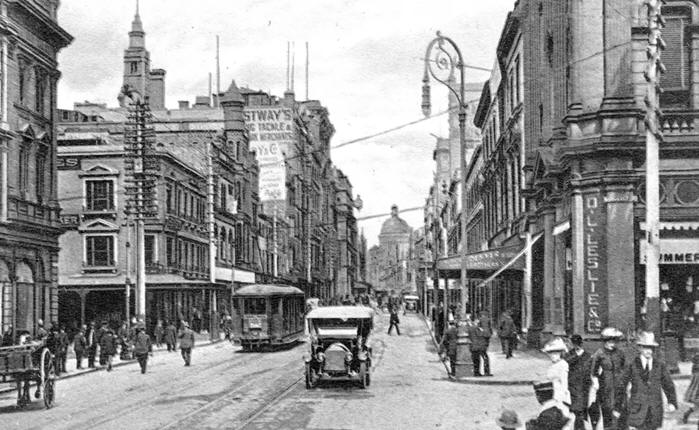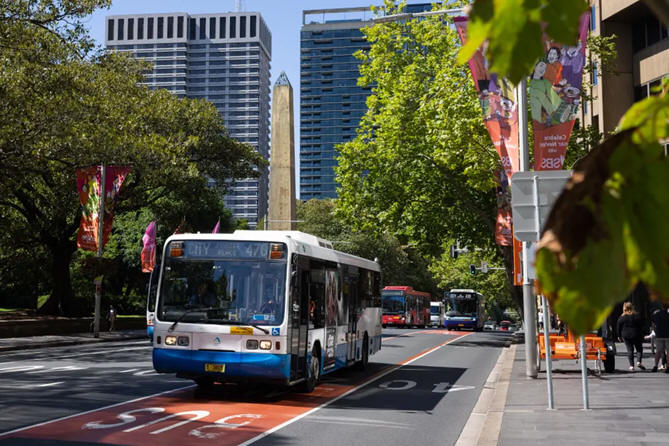Snail rail: why are trams in Australian cities running slower than they were 100
years ago?
The Guardian -
Elias Visontay Transport
and urban affairs reporter -
Sun
22 Jan 2023

Commuters wait for a tram at a light rail station in the CBD of Sydney, NSW, Australia.
Sydney’s light rail network is among the slowest in the country, new analysis shows, and tram lines around the country share similar problems. Can anything be done to speed them up?
Trams on a recently revived light rail route in Sydney and on one Melbourne line are so slow they would be outpaced by trams that ran almost 100 years ago, new analysis reveals.
Sydney’s light rail network is among the slowest in Australia – a country where speeds on many lines are going backwards.
Experts argue light rail is deliberately being held back by operators “padding timetables” so it is easier to meet performance targets and also due to stricter attitudes towards safety.
Tram speeds across Australia generally lag behind foreign cities, making some services uncompetitive with cars and other modes of transport, according to the analysis by Dr Geoffrey Clifton from the University of Sydney’s Transport and Logistics Management Institute, and Duncan MacAuslan and Geoff Lambert from the Australian Timetable Association.


George Street, Sydney, Australia - pre 1960s before the original tram network was ripped up and now with the modern light rail.
But, in better news, light rail systems on the Gold Coast and in Canberra – which benefit from tracks largely uninterrupted by road traffic and pedestrians – host the fastest tram services in Australia, with average speeds exceeding 30km/h even when factoring in stops.
Melbourne’s historical tram network broadly outperforms Sydney’s when it comes to travel times, where, even on tracks laid in recent years featuring modern technology, trams move much slower.
Passengers boarding Sydney’s light rail at the recently rebuilt Circular Quay stop heading south through the newly pedestrianised George Street to Central station travel at an average speed of 11km/h.
Average speeds do, however, increase on other routes, with services on the Central to Dulwich Hill line averaging 20km/h. Trams travelling from Central to Randwick and Juniors Kingsford average 21km/h, which is higher than when the lines opened in late 2019 and April 2020, and there were restrictions in place to help road users get used to the new trams.
Sydney’s vast original tram network was torn up in the 1960s, with a few sections rebuilt in recent years. But the modern-day system lags behind historical speeds in some areas.
Historic timetables reveal that in 1937, trams ran from Circular Quay to Central station at an average speed of 16km/h – 5km/h faster than current speeds – despite travelling an identical length of track.
Speeds elsewhere in Sydney have improved. In 1944, trams ran from Juniors Kingsford – an area then known as Daceyville Junction – at an average of 18km/h, which is 3km/h slower than current speeds. The modern-day track is also 400 metres shorter than the 20th-century route.
In 1944, trams ran from Liverpool Street to Alison Road in Randwick at an average speed of 19km/h, meaning trams currently serving that route have increased their average speed by 2km/h in the almost eight decades since – although the route has changed slightly.
In Melbourne, similar to Sydney, present-day trams also run slower within the city centre. The 30 tram, running between St Vincent’s Plaza and Central Pier, averages 11km/h, which is in line with Sydney’s slowest route.

Elizabeth Street, Sydney, Australia – trams once ran long the street, which has now become a busy thoroughfare for buses.
The 75 tram from Spencer Street to Hawthorn Bridge averages 14km/h, while the 109 tram from Port Melbourne to Box Hill travels at an average speed of 17km/h. Speeds increase dramatically on other routes – the 86 tram from RMIT Bundoora to Albert Street, Reservoir, travels at an average speed of 25km/h.
In 1921, trams travelled from Spencer Street to Hawthorn Bridge at an average speed of 16km/h – 2km/h faster than current speeds. However, on other parts of Melbourne’s network, speeds have improved. The 78 tram averaged 12km/h between Balaclava and North Richmond in 2000 but now runs faster, averaging 14km/h over the same distance.
Why do some trams run slower than others?
Clifton said tram routes that run through the city centres of Sydney and Melbourne consistently run slower than suburban routes due to more frequent stops, longer dwell times because of higher passenger numbers and as a consequence of more interference from traffic.

Trams make their way through Sydney’s CBD in NSW, Australia, during morning peak hour.

A tram speeds up as it heads towards Surry Hills away from Sydney’s CBD.
He said passenger numbers and traffic have also increased over the past century – another possible factor for speeds on some lines slowing down.
In Adelaide’s CBD, trams between South Terrace and Royal Adelaide hospital average just 10km/h. Trams average 22km/h between South Terrace and Glenelg – slower than in 1976 when they averaged 29km/h on the same route.
Trams also run slower through Newcastle’s CBD, where the average speed on the light rail line is 14km/h.
While factors limiting Sydney’s modern light rail include the heavier and longer size of trams in service and the recent pedestrianisation of some streets, as well as the city’s hillier topography, transport experts believe Sydney’s network is capable of running faster.
Clifton said public transport operators commonly manipulate timetables to allow for over generous trip times, which makes it easier for performance targets to be achieved.
“Timetables themselves can encourage slower travel,” he said. “Operators and governments always want transport to run on time, and the easiest way to run on time is to slow the timetable down. Some operators around Australia are known for padding timetables out so they don’t get in trouble if they run slow.

A Metro tram in Victoria Square in Adelaide, South Australia
“Transport planners, the private operators and the drivers could all get together and look for ways to speed things up, but if there’s too much conflict, they’re going to say no, keep things slow so we always hit our target.
“You’ve probably heard the saying that Mussolini made the trains run on time, and that’s how, he redid the timetables.”
However, there are genuine physical obstacles keeping some trams slow. Clifton said acceleration and deceleration of Sydney’s vehicles was one factor contributing to their sluggishness.
“Some newer trams can actually have slower acceleration than older ones because they’re bigger and have more tech, and on routes with more curves and hills, the slower the vehicles are going to go,” Clifton said.
Acceleration can play an even bigger role in slowing down trams on routes which do not have their own exclusive lanes or separate corridors. He says this is why trams on the Gold Coast and in Canberra run faster than in Melbourne and Sydney.
“More stopping and starting due to pedestrians, cars and traffic lights, means the less time the trams can accelerate at their best speeds.”
Traffic light priority for trams
Road rules also make a big difference in mitigating the impact of traffic. Melbourne’s tram system includes 250km of double track – the largest network in the world – and about 75% is shared with other road users.
Despite this, Melbourne trams frequently average decent speeds because they can glide through intersections. This is due to trams long having had priority at traffic signals, a Victorian transport department spokesperson said.

Trams running along Melbourne, Victoria’s, busy CBD thoroughfare, Swanston Street.
Tramcars are fitted with transponders that are picked up by detectors placed in the lead up to intersection, so when a tram is approaching, a green light will appear at the intersection earlier to maximise the chance of the tram getting through without stopping.
On some roads, trams are also able to activate a right turn phase to clear right turning vehicles queued in the path of the tram.
Authorities in Melbourne are even planning to bolster tram priority by sending real time GPS data from trams to crosscheck it against the timetable to create more favourable traffic lights and clear intersections ahead if the tram is running late.
However in Sydney, the level of traffic light priority given to light rail is dependent on the geometry of the site, but is also balanced with the needs of other road users, according to the state’s transport department.
Transport for NSW notes that the trip time from Kingsford to the city has dramatically decreased since the line was launched.

Gold Coast, Queensland, hosts one of the fastest tram services in Australia, with average speeds exceeding 30km/h.
Erring on the side of safety
Clifton says Australian attitudes towards safety, which often err on the side of caution, also contribute to slower tram speeds.
“We tend to be a bit more conservative in Australia. We don’t want to injure people. We see overseas trams go faster because they have more of an appetite to increase capacity and squeeze an extra service in the timetable.”
He says trams overseas accelerate fast out of stops, but that there is less cultural acceptance of this for riders and from other road users in Australia.
“If you’ve been on the London underground or trains and trams in other countries, you’ll feel a faster acceleration than in Australia, where we’re quite cautious of other people when accelerating.”
Clifton added that tram driving styles have also changed in Australia in recent decades.
“You hear stories of tram drivers in Sydney in the 50s racing to see how fast they could go, but there’s oversight now, and drivers don’t want an accident.”